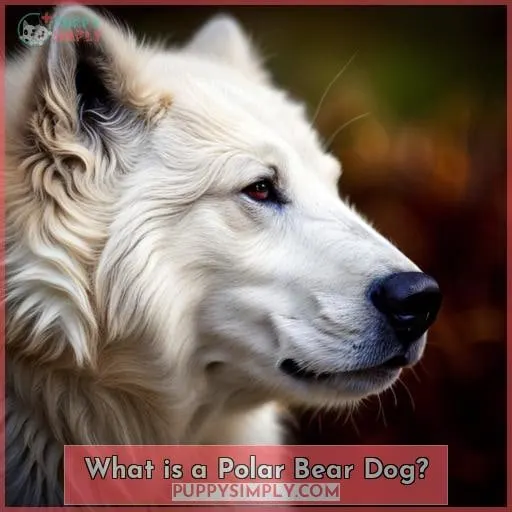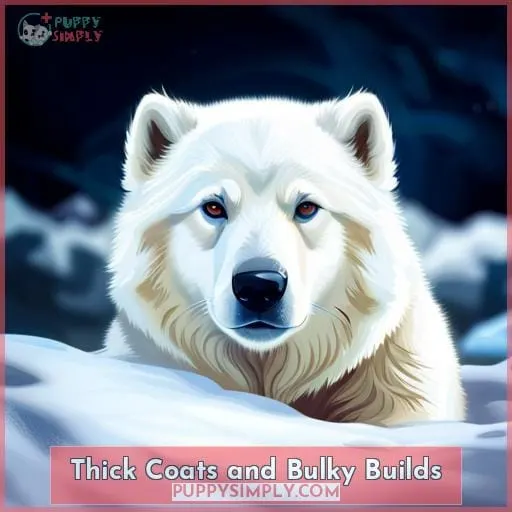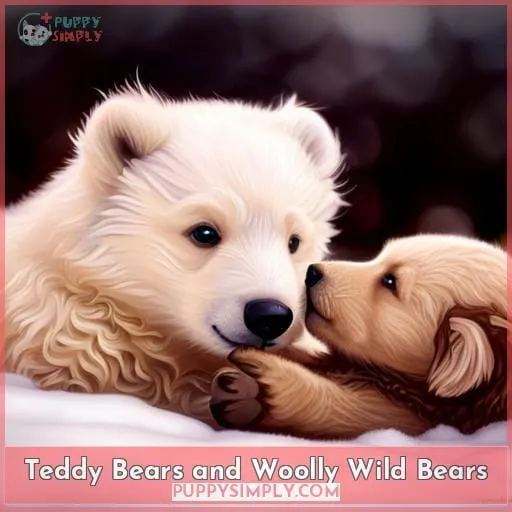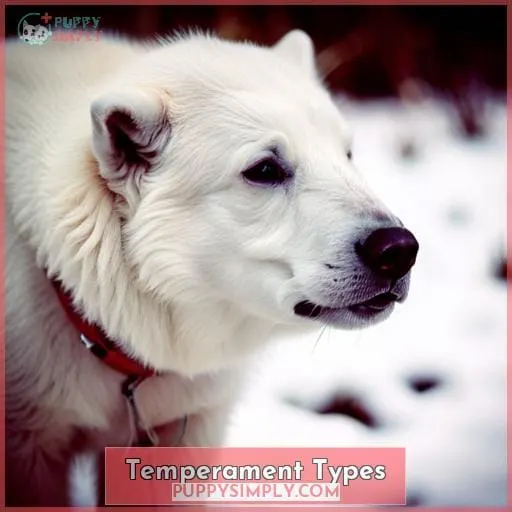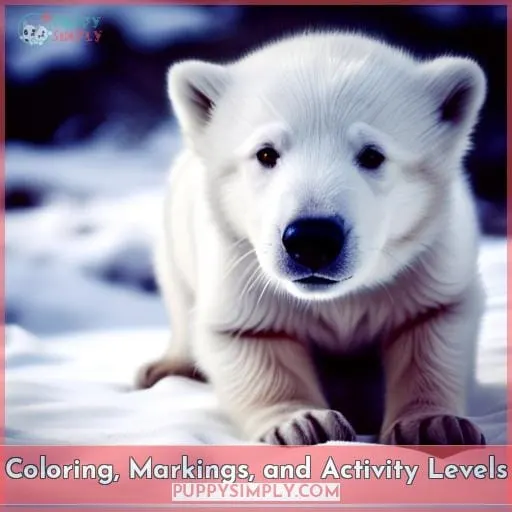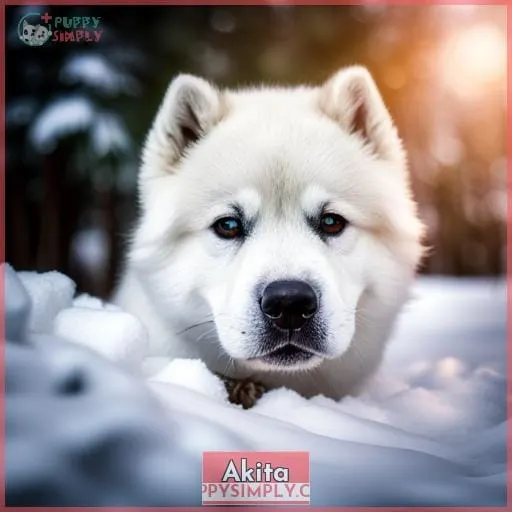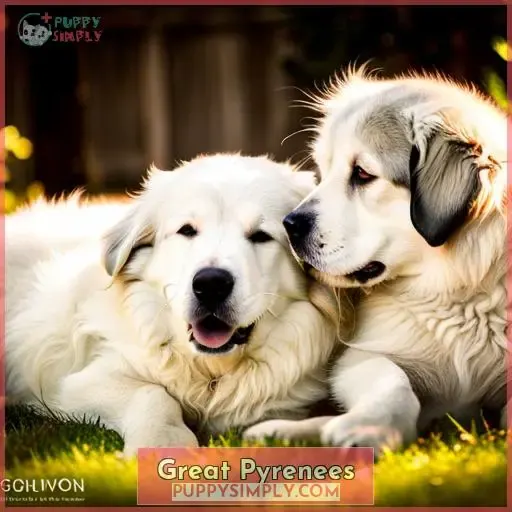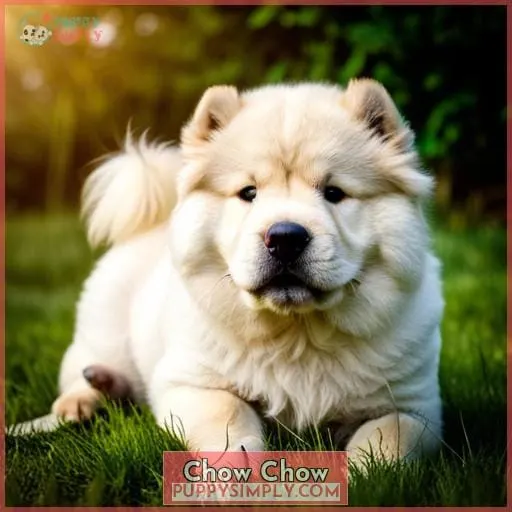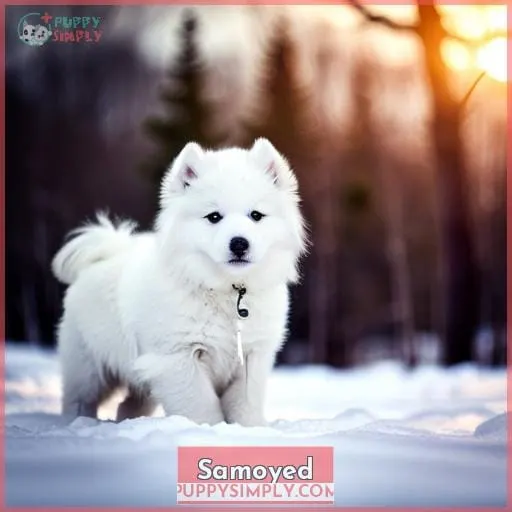This site is supported by our readers. We may earn a commission, at no cost to you, if you purchase through links.
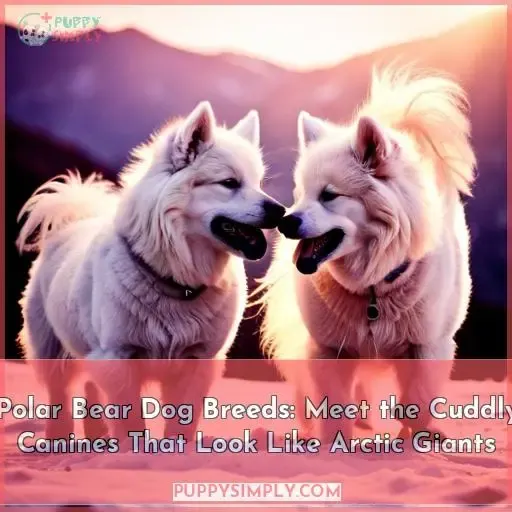 Did you know that there are dog breeds that look strikingly similar to polar bears?
Did you know that there are dog breeds that look strikingly similar to polar bears?
These polar bear dogs captivate with their thick, white coats and friendly demeanors.
In this article, we’ll introduce you to nine of these cuddly canines, exploring their unique characteristics, temperaments, and origins.
From the majestic Akita to the playful Samoyed, get ready to meet the furry doppelgangers of the Arctic giants.
Table Of Contents
Key Takeaways
- Thick double coats provide insulation and vary in color from white to cream to black.
- Temperaments range from dignified to playful depending on the breed; early socialization is key.
- Regular brushing prevents matting and tangles in their dense fur.
- Popular breeds include the Akita, Great Pyrenees, Chow Chow, and Samoyed.
What is a Polar Bear Dog?
If you’re looking for a dog that resembles a polar bear, there’s a whole world of breeds out there waiting for you.
These dogs, often called polar bear dogs, share several striking similarities with their Arctic counterparts, including thick, plush coats, bulky builds, and an air of cuddly charm.
Polar bear dogs come in various shapes and sizes, with temperaments ranging from calm and dignified to playful and energetic.
Some breeds, like the Chow Chow, are known for their aloof independence, while others, like the Samoyed, are renowned for their friendly and outgoing nature.
No matter their size or personality, all polar bear dogs require special care to maintain their thick coats and overall health.
Regular brushing, occasional baths, and a healthy diet are essential for keeping these dogs looking and feeling their best.
They also need plenty of exercise to stay happy and healthy.
With the proper care and attention, polar bear dogs make wonderful companions for people of all ages.
Their striking appearance and gentle nature make them popular choices for families with children and those seeking a loyal and loving pet.
Thick Coats and Bulky Builds
Now, let’s explore their distinct physical attributes that make them resemble polar bears.
These dogs typically possess thick, double coats that serve as natural insulators, protecting them from extreme temperatures.
The dense undercoat traps warm air close to their bodies, while the longer guard hairs repel water and dirt.
This luxurious coat may come in a variety of colors, including white, cream, black, and even blue.
Their bulky builds contribute to their bear-like appearance.
These dogs have broad chests, muscular shoulders, and sturdy legs that enable them to navigate rugged terrain with ease.
Some breeds, like the Great Pyrenees, can weigh up to 150 pounds, while others, like the Chow Chow, are more compact, weighing around 70 pounds.
Despite their impressive size and thick coats, these dogs have moderate exercise requirements.
Regular walks or playtime in the yard are usually sufficient to keep them happy and healthy.
However, they do require regular grooming to maintain their coats in top condition.
Brushing a few times a week helps prevent mats and tangles and keeps their coats looking their best.
Teddy Bears and Woolly Wild Bears
You’ll be amazed by polar bear dogs’ resemblance to cuddly teddy bears and woolly wild bears. Their thick, luxurious coats and bulky builds create an undeniable likeness to their Arctic counterparts.
Picture a Chow Chow with its distinctive lion’s mane and dignified demeanor, embodying the essence of a regal polar bear.
For those seeking cold-weather companions, breeds like the Samoyed and the Great Pyrenees offer both beauty and practicality. Their thick, double coats provide ample insulation, making them ideal for outdoor adventures in snowy climates.
Additionally, some polar bear lookalikes, such as the American Eskimo and the German Shepherd, are known for their hypoallergenic qualities, making them suitable for allergy-prone individuals.
Whether you’re seeking a loyal apartment-friendly polar bear like the Japanese Spitz or an outdoor adventure buddy like the Siberian Husky, polar bear dogs offer a diverse range of temperaments and activity levels to suit various lifestyles.
Their captivating resemblance to polar bears, combined with their affectionate and playful nature, makes them irresistible companions for those seeking a furry friend with a touch of the wild.
Temperament Types
Their temperaments vary, from the dignified Chow Chow to the playful Samoyed.
Chow Chow:
- Dignified, serious, aloof, independent, loyal, and clean.
- They require little exercise and are content as house pets.
Great Pyrenees:
- Gentle giants, intelligent, family-friendly, loyal, and protective.
- They need a job to do and may act out without one.
Samoyed:
- Playful, friendly, loyal, energetic, and alert.
- They’re pack animals that thrive off interaction with devoted owners.
Other Polar Bear-Like Dogs:
- Temperaments vary depending on the breed.
- For example, the American Eskimo Dog is active and social, while the Hokkaido Dog is loyal and courageous.
Understanding the temperament of each breed is crucial before bringing one of these majestic creatures into your home. Early training and socialization are essential for these social animals to ensure they grow into well-behaved companions.
Regular grooming, including weekly brushing and monthly baths, is also necessary to maintain their beautiful coats.
Coloring, Markings, and Activity Levels
Exploring the fascinating spectrum of colors, markings, and energy levels within polar bear dog breeds will unveil their distinct personalities.
From the dignified Chow Chow, with its regal mane and serious demeanor, to the playful Samoyed, with its infectious smile and boundless energy, each breed possesses a unique charm.
Their coats, often double-layered for insulation, come in a mesmerizing array of hues, from classic white to striking cream, resembling polar bears roaming snowy landscapes.
Embrace the adventure of grooming their plush coats, a labor of love that ensures their comfort and well-being.
Discover the rich history of these breeds, from herding instincts honed over centuries to flock protection deeply ingrained in their DNA.
Engage with these gentle giants, understanding their innate desire to safeguard and nurture, making them exceptional companions for families seeking unwavering loyalty and unwavering affection.
Akita
Your Akita’s temperament is quiet, temperamental, and often difficult to train.
But don’t let that deter you; these intelligent canines are fiercely loyal and make excellent companions for experienced dog owners.
Their thick coats, rounded ears, and subtle bear-like quality give them an air of regality.
Originally bred for hunting and guarding in the mountainous regions of Japan, Akitas possess a strong prey drive and a protective nature.
Early socialization and consistent training are crucial to ensure they grow into well-behaved members of your family.
Akitas are generally healthy dogs, but they’re prone to certain health conditions like hip dysplasia and eye problems.
Regular veterinary care and a healthy diet are essential for maintaining their well-being.
Their thick double coats require regular brushing to prevent mats and tangles.
Akitas are moderate shedders, so be prepared for some fur around your home.
With proper care and attention, your Akita can live a long and healthy life, bringing joy and companionship to your family for years to come.
Great Pyrenees
If you’re looking for a gentle giant, the Great Pyrenees might be the breed for you.
These working dogs, bred in the Pyrenees mountains, possess a Zen-like patience and a family-friendly demeanor.
Their thick, white double coat, resembling a polar bear’s, is dirt- and tangle-resistant, but sheds its undercoat in spring.
Regular brushing with a slicker brush during shedding season is crucial.
Great Pyrenees are renowned for their loyalty and protectiveness toward their family.
They thrive in environments with ample space to roam and jobs to do.
Without a purpose, they may exhibit undesirable behaviors.
Their intelligence and trainability make them responsive to commands, although early socialization and training are essential.
Despite their large size, Great Pyrenees are gentle and loving companions, making them excellent family pets.
Their calm and composed nature brings a sense of safety and security to their human pack.
If you’re seeking a majestic and devoted canine companion, the Great Pyrenees may be your perfect match.
Chow Chow
In terms of appearance, the Chow Chow boasts a thick mane, muscular build, deep chest, and furry coat, making you think of a cuddly teddy bear.
Don’t be fooled by its adorable looks, though—this dignified, serious, aloof, and independent canine demands respect and loyalty.
Chows can trace their lineage back to ancient China, where they were revered as guardians of temples and palaces.
Despite their independent nature, Chows are fiercely loyal to their families and make excellent companions for those willing to invest time in training and socialization.
Chows require regular exercise and grooming to maintain their thick coats and overall health.
Samoyed
Meet the Samoyed, a playful, friendly, and loyal breed that resembles a small polar bear.
With its thick, fluffy white coat and equally fluffy tail, this breed exudes an irresistible charm that makes it a popular choice for families.
Originally bred as sled dogs and reindeer herders in northern Russia, Samoyeds possess an innate love for the outdoors and thrive in cold climates.
Their angora-like fur, reminiscent of Arctic landscapes, provides excellent insulation, allowing them to withstand harsh weather conditions.
As pack animals, Samoyeds crave interaction and attention from their devoted owners.
They excel in various roles, including working dogs, medical detection dogs, and service dogs, showcasing their versatility and intelligence.
Here’s a table highlighting the Samoyed’s key characteristics:
| Trait | Description |
|---|---|
| Temperament | Playful, friendly, loyal, energetic, alert |
| Appearance | Thick, fluffy white coat, equally fluffy tail, small polar bear look |
| Group | Working |
| Height | 21 to 23.5 inches (males); 19 to 21 inches (females) |
| Weight | 45 to 60 pounds (males); 35 to 50 pounds (females) |
Frequently Asked Questions (FAQs)
What are the grooming requirements for polar bear dog breeds?
You must regularly brush their dense double coats and bathe monthly.
During shedding seasons, increase brushing to remove loose hairs.
Bathing and drying the undercoat helps remove excess shedding fur.
Daily exercise provides needed stimulation and bonding time.
How much exercise do polar bear dog breeds need each day?
Depending on the breed, polar bear dog breeds need 30 minutes to 2 hours of exercise per day.
Higher energy breeds like Samoyeds and Hokkaidos require over an hour of vigorous activity.
Lower energy breeds like Chows and Pyrenees only need a 30-minute walk.
Give your dog the type and amount of exercise it was bred for.
What health issues are common in polar bear dog breeds?
You may see bone and joint issues like hip dysplasia.
Eye problems like cataracts are also common.
Regular vet checks and preventative care can help mitigate risks.
Stay on top of their health to maximize their years by your side.
How much do polar bear dog breeds typically cost to purchase?
On average, polar bear dog breeds cost $1,000 to $2,500 from a reputable breeder.
You should budget extra for:
- Vaccinations
- Neutering
- Pet supplies
- Training
Look for a breeder who health tests their dogs for genetic issues common in the breed.
Avoid backyard breeders and pet stores.
Are polar bear dog breeds good with children and other pets?
Many polar bear dog breeds are gentle giants and affectionate, making them wonderful companions for children when properly socialized.
Supervision is still advised, as no dog should ever be left alone with young kids.
Proper training and socialization is key for ensuring safe interactions with children and other pets.
Conclusion
As you explore the world of polar bear dog breeds, you’ll discover a captivating array of personalities and appearances.
From the dignified Akita to the eternally playful Samoyed, these canine companions embody the essence of the Arctic giants they resemble, offering a unique blend of loyalty, affection, and unwavering companionship.
Embrace the warmth of their thick coats and the joy of their friendly spirits as you welcome one of these extraordinary creatures into your life.

